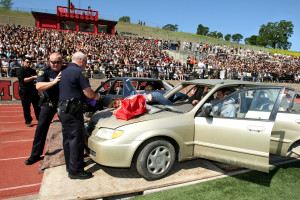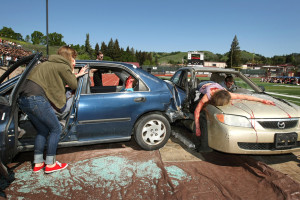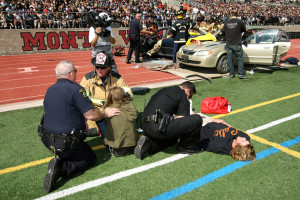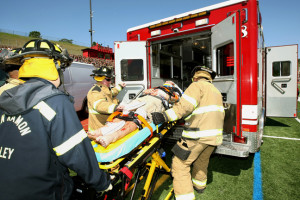On D-Day, seventy years ago, the Invasion of Normandy changed the course of the World War. The daring surgical strike against German-Occupied France was the catalyst that deterred Adolf Hitler’s forces from further entrapping Europe in deadly quicksand of possible all-out defeat.
The Nazis invaded Poland in 1939 and by 1944 already occupied several European nations. The continent was still reeling from the Great War that had ended in 1918—a mere two decades earlier.
To deter Britain’s anticipated attacks from the sea, German forces constructed fortifications along the Western Front known as “The Atlantic Wall.” The Nazi Military Machine secured 2,400 miles of coastline facing Britain from the Bay of Biscay to Arctic Ocean, in France, Belgium, Holland, Denmark, and Norway, with a force of 300,000 troops.
They constructed the coastal Atlantic Wall with millions of tons of cement and steel barricades, fortified with observation towers, encampment bunkers, pillboxes, gunnery emplacements, machine gun nests and impenetrable fortifications to repel attacks. Some subterranean hideouts had sleeping quarters and mess halls as well as defense weaponry. Along the French coast, many bunkers were camouflaged caves carved into cliffs while others were disguised as quaint cottages with Mansard roofs, dummy doors and phony lace curtains.
The Nazis had spent two years constructing the Atlantic Wall with a quarter million foreign conscripted slave laborers, POWs and workers from French Colonies in Asia. They were ill-fed and worked to death.
The Allies had to break through the near-impregnable coastal wall to defeat the Third Reich’s tyranny.
The prelude to the Normandy land battle was the vital air support of a 24,000-strong force, supplied by a trinity of nations; Britain, Canada and the United States. The RAF (Royal Air Force) and U.S. Army Air Force flew continual air assaults to pulverize and disable the Nazi fortifications. And on the night of June’s first full moon the bombardment of Nazi military installations was guided by ribbons of moonlight in nearby rivers.
The targeted air bombardments on fifty-miles of coastline weakened the Atlantic Wall for the dawn landings of thousands of men. American GIs, along with British and Canadian units, were to be dispatched from an armada of over 5,000 ships to LSTs (Landing Ship Tanks) and amphibious crafts. 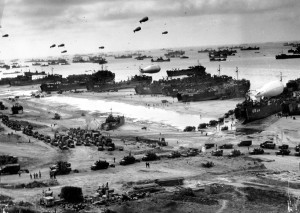
The D-Day Invasion of Normandy was the largest such operation ever executed in world history, with simultaneous surgical assaults from all sides by air, land and sea. Allied Ground Forces stormed five targeted beaches at first light, knowing full well they were entering the Jaws of Death, and knowing when they set foot on the shores they would take hits from 88 mm artillery, mortars, rocket launchers, howitzers, machine gun fire, flame throwers, snipers and deadly land mines.
Demolition crews were among the first to rush beaches to neutralize mines; many blown to pieces before the sun came up. Cruisers, destroyers and troopships took mortar fire. Over 5000 sitting duck ships, vision cut by burning oil, loaded with supplies, tanks, Jeeps and trucks, were in the enemy’s scopes.
Vehicles landed, traversing the mined sands, soldiers following behind, stepping in the wheel ruts, others rushing to shelter in the dunes, Rangers rappelling cliffs. Smoke, fire, noise, explosions; mayhem was everywhere. Men lay dead or dying, Medics rushed and radios blared. Demo crews set charges to detonate mines; they took the biggest hits.
Coastal shorelines were mined and strewn with lethal steel obstacles to capsize landing craft and kill intruders; tetrahedral spikes, half-buried mines, mined spikes, and dragons’ teeth tank deterrents. Allies needed good vision to breech the shores at first light.
The trinity of Allied Forces in Operation Overlord were to land on five different beaches, codenamed Utah, Omaha, (U.S.) Gold, Juno (Britain) and Sword (Canada). Britain’s launch points were Falmouth, Slapton, Portsmouth and New Haven.
The Allied beach raiders were delivered to channel waters by 5000 Naval and Merchant Navy ships carrying 195,000 men to be dispersed into amphibian vessels to the shores. Even though logistics of such an operation must have been nightmarish, the operation worked like clockwork.
General Dwight D. Eisenhower, Supreme Commander of the operation, in retrospect, was the military’s most daring General. He understood the forces’ penetration of the Atlantic Wall would depend upon favorable weather and tides, and yet the death toll would be still be horrendous. Eisenhower knew the danger the invasion posed. He understood that Operation Overlord could fail—and fail badly—and was aware that tens of thousands of Allied Forces could perish. But the warrior extraordinaire had raw guts, stamina, courage, and was a brilliant military strategist. He had the fortitude to take the chance, and through sheer military genius, changed the course of history.
General Eisenhower had arrived in Britain in January 1944 to set about planning the proposed invasion. He butted heads with Britain’s top military echelons including Prime Minister Winston Churchill. His strategic design for Victory in Europe was laid out with all possible scenarios. Planners knew weather and tides were to be a determining factor, and that they had to wait until conditions were viable for thousands of warships to cross the rough English Channel. The weather had a mind of its own, as winds could turn within hours. 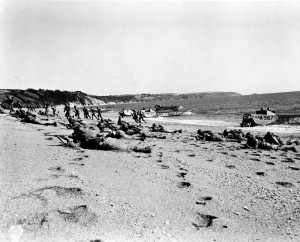
Members of the Supreme High Allied Expeditionary Forces (SHAEF) consulted Britain’s best military meteorologists. Countdown to victory commenced early June, 1944. There was no precedent for such a mighty invasion with the largest armada ever assembled in military history. The 1942 Invasion of Sicily had enabled Allied Forces, under Patton and Montgomery, to traverse to Northern Italy, and now they were poised to penetrate the Atlantic Wall.
So, a full moon night Tuesday 6th day of June was targeted to enter a new phase in world history. The Invasion of Normandy was to be the event that turned the currents of war, leading to the greatest eventual victory the earth would ever see.
The Bravest of Men
Allied troops waiting in the south of England for orders were chomping at the bit, ready for action. Training sessions warned of the danger of even talking about the upcoming invasion. Allied troops were sequestered in fenced camps weeks before D-Day—not allowed to communicate with family or girlfriends by phone, cable or mail. Coastal residents were relocated ten miles away from all southern shorelines.
The mission of the jumpers in the U.S. 82nd and 101st Airborne “Band of Brothers” was to parachute behind enemy lines and destroy exit roads and bridges to thwart the enemy’s retreat. For weeks they had studied aerial reconnaissance photographs, topographical maps, and mock-up models of the Normandy terrain for night jumps.
By the time the jumpers parachuted from planes and gliders behind enemy lines, they had memorized layouts of the white cliffs jutting into Etretat Bay, contours of each beach, patchworks of Bocage region green fields with thickets and hedgerows, and the roads and bridges they had to sabotage. Allied troops knew not to bomb historic landmarks or the fabled Le Mont Saint Michel, the medieval abbey near Caen that loomed high on a rock island.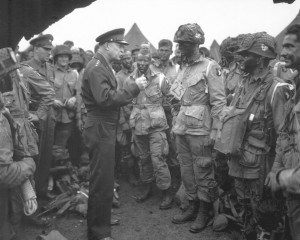
Royal Air Force and U.S. Army Air Force provided air support by bombing the targeted region day and night, to soften up the enemy and penetrate the formidable Atlantic Wall. RAF Hurricane and Spitfire planes were on alert at Dover Base to fly missions on a minute’s notice. Many pilots were killed or captured; thousands never returned.
The Supreme Commander confirmed day and hour; wheels were set in motion for nearly 200,000 Allied troops to reach Normandy beaches before daybreak. One can imagine the orders; dismantle mined obstacles, assault German strongholds, clear out weapon and machine gun nests, neutralize the enemy, fight like hell and complete the mission.
The operation at hand lasted many days. Twenty percent of the Allied troops died and thousands were maimed before they forged north to Paris.
The build up to Operation Overlord was Top Secret; only a handful of inner circle planners had “For Your Eyes Only” access. British Agencies were ordered to disseminate false stories through Intelligence outlets and leak fictitious names and dummy armies. Faux info leaked that Allied Forces were poised to attack Pas-de-Calais on France’s northern shores in July. Spies and double-agents picked up phony information and German forces further reinforced the northern Atlantic Wall other than the actual targeted regions.
Knowing that Luftwaffe spy planes were reconnoitering British coasts, they constructed false military bases, and phantom forces were assigned to mighty General Patton. Set decorators from Shepperton Film Studios built Hollywood-style, faux, one-dimensional barracks, dummy planes and rubber blowup-trucks; the façade described as “The Eye of the Needle.”
An already-dead military man, “The Man Who Never Was,” disguised as an intelligence officer, was dropped into the sea from the air with false documents outlining an imminent attack on different shores. Germans retrieved the corpse washed ashore and presumed they had recovered valid, secret Intelligence. They were still buoyed with power after ousting the British Expeditionary Forces four years earlier in Dunkirk.
So, the Nazis were unprepared for the mighty Normandy raiders; unprepared that such brave warriors would knock down their monumental wall, and were totally unprepared that their elite forces would be decimated.
Dunkirk
Almost four years prior to D-day, in mid-1940, Nazi behemoth Panzer tanks had pushed 338,000 soldiers of British Expeditionary Forces, including 100,000 Frenchmen, towards the English Channel. They were trapped in Dunkirk Harbour on the far Western Front, backs to the wall, with no escape route but the cruel sea.
Britain’s War Office alerted “everything that could float,” to rescue the trapped men from impending massacre. Big ships and small boats rushed all night from Dover to Dunkirk, navigating the 50-mile channel through watery mine fields.
Known as Operation Dynamo, lifesavers participated in the makeshift flotilla; a cruiser, 39 destroyers, yachts, ferries, trawlers, tugboats, gunboats, sail boats, motor boats, fishing boats, rowboats and lifeboats navigated the choppy channel. Indefatigable rescuers ferried soldiers to offshore transit ships, dodging strafers for nine solid days until the last man was out of Dunkirk.
Luftwaffe planes and surface vessels continually bombed rescue vessels in all-out attack as they rowed soldiers from the harbor. Sixty-eight thousand died, and 861 boats were sunk, but they never stopped the valiant rescue effort.
The Legend of the Little Boats is one of the war’s most beloved stories. Every rescuer, British and French, was honored with the Saint George’s Cross flag that they proudly flew above their humble barks, telling of their bravery at Dunkirk.
Germans did not succeed in killing them all, nor did they break the inimitable British spirit, but they commandeered the abandoned tanks, trucks, fuel tanks, ammunition and artillery weaponry; in all, a treasure trove of British engineering secrets. 
On the home front, exhausted from Blitzkrieg bombings, and with the Dunkirk near-massacre in mind, troops waited to proceed. Britain was poised to attack with over 150,000 Canadians, and 1.5 million American Servicemen and women stationed in England.
General Eisenhower, Supreme Commander, was assisted by six others, including General Omar Bradley and Sir Bernard Montgomery. They confided the invasion plans to King George VI just before departure. Prime Minister Churchill said that General Eisenhower was the most powerful man in history.
The General knew every order of battle, every minute detail of each division’s time schedules, and knew that many must die on that fateful day to save others from Hitler’s horrific tyranny.
It would be years before the world would be stunned by the war’s death toll at about 50 million, and General Eisenhower could not know at that point of battle, that over 405,000 United States Military personnel would die before the war ended in 1945.
Bitter Victory
There were thousands of behind-the-scenes strange stories that affected the war. One such bizarre incident was a perceived Intelligence breach that caused alarm. An incredible coincidence nearly deep-sixed the entire operation five weeks before the invasion. An unassuming physics teacher, Leonard Dawe, a puzzle compiler, submitted five weekly crossword puzzles to London’s Daily Telegraph newspaper. Clues included the top secret code-words used for the Normandy Invasion; Utah, Omaha, Neptune, Overlord, and Mulberry—code for artificial harbor tide breakers.
Military officials were convinced a spy was supplying Intel to the enemy. Scotland Yard picked up the puzzle compiler. After interrogation they concluded it was all just an incredible coincidence. The operation proceeded as planned.
Such stories make up the war’s tapestry. Prime Minister Winston Churchill warrants mention; already a seasoned warrior from the South African Boer War and WWI. He was crusty, adamant, and steadfast; a man of raw courage. He also gave the most astounding “blood, guts, and spirit” speeches in Parliament. Churchill’s “our darkest hour” speech will live forever.
Churchill’s biting telegrams and letters to President Roosevelt, begging for ships, are legendary. His threats to the then neutral America as being in the Nazis’ gun sights were bloodcurdling. Pearl Harbor attacks by the Japanese in 1941 slammed the Americans into the wartime European Theatre. The “Yanks” jumped in with guns ablaze and saved Britain.
When France, Britain’s ally, capitulated to Axis Powers, Churchill feared the Germans would take the fleet of French warships. He gave the admiral an ultimatum; scuttle all French naval ships or the British would blow them to smithereens. When the French declined, Churchill ordered Royal Navy warships from Gibraltar to bombard the cruisers and destroyers with deadly firepower. British warships blasted them with 14-inch guns sinking them into the sea off French Algeria. The collateral damage was over a thousand French sailors.
Parliament applauded Churchill’s resolve to beat Germany, and when Roosevelt realized the warrior was serious about winning the war, he sent warships and supplies to Britain’s aid.
When one of history’s most important forecasts promised good weather; spring tides and a full moon—they set Operation Overlord for Tuesday, 6th of June. To alert French Resistance fighters of the imminent invasion, BBC radio broadcast lines from Verlaine’s poem, “Wound my Heart with Monotonous Langour.” The Resistance partisans, crucial to the invasion’s success, were ready for the Allied night jumpers and started blowing up trains, rails, roads and bridges.
It can only be imagined how operation logisticians must have anguished about the 5000 ships carrying planes, weapons, minesweepers, amphibians, pontoons, LCTs, 150,000 jeeps, trucks, tanks, planes, food and medicine. And brilliant military innovation supported the logistics of transporting hundreds of thousands of men crossing the choppy channel to target the beaches at first light.
We have seen the blood and guts movies and have read historic reports. We know about D-Day—or do we? We may never understand what those brave young men were thinking. We may never know how calmly they faced potential death, and we will never understand, even upon entering the Jaws of Death, they were able to remain steadfast, on to glory.
Could those courageous men of the Allied Forces have known on that grey morning that within hours of storming the beaches that twenty percent of them would lay dead on the sands?
While films such as The Longest Day, and Saving Private Ryan, and scores of British, J. Arthur Rank films, tell vividly of the horror, no movie can hope to explain the thoughts of those young, brave men, on that fateful morn.
To confuse the enemy and jam radar, Allies parachuted dummies and tinfoil chaff, and bombarded installations the night before. And on the morning of June 6, 1944, air support planes struck the coast with 11,000 sorties targeting railroad junctions, gun positions, and troop concentrations.
Californians 1st Lt. Anthony Pavone and 2nd Lt. Archie Maltbie were among the raiding pilots on that fateful day.
Pavone, a longtime family friend, recounted his personal account to my daughter Antonia. Anthony Pavone, 94, was a 1st Lt. in the Army Air Force, one of the D-Day pilots. His reaction to that day; “There were a lot of ships and boats out there—we were up in the altitude, couldn’t see the people getting killed—I assumed they were—it’s so far behind me, I don’t remember…I flew over and bombed the Germans ahead of the landing forces.” Asked what he had learned from the war he responded wisely; “War doesn’t pay…”
Archie “Lin” Maltbie, 90, was a fighter pilot flying P-47 Thunderbolts with 365th Fighter Group of Ninth Air Force—the “Hell Hawks” 388th Squadron. He signed up at 19, sailed on Queen Mary and was stationed in England three weeks before D-Day.
Archie tells of cross-channel missions on D-Day; strafing and bombing in the morning, again that afternoon to hit inland and coastal gun positions. “We were up before dawn, got briefed on our mission…skies were full of U.S. planes. On D-Day morning, thousands of ships were down there, so close you could walk from one to another like stepping stones. We saw red in the water. Blood tinted the beaches. I recall shell bursts, tracer bullets flying—it was rough down there. After D-Day we flew from French soil on leveled fields.”
Archie had already shot down enemy planes, and that August, flying at 300 mph, gunned a German ME 109. The Messerschmitt’s exploding debris blew to his canopy disabling the P-47. He baled-out, seconds before it blew up.
Maltbie parachuted, landed in a woodsy area near the River Seine, infested with Germans. Armed with a silk map and French phrase book, he was taken in by a family with the French Underground. He gave up his uniform, got a Basque passport and blended in. During German farmhouse inspections he pretended to be mute thus securing his faux Basque identity.
Lt. Col. (Ret.) Archie Maltbie, a retired pharmacist lives in San Jose, has two sons, grandchildren and great-grandchildren. He wrote the foreword for a recently-published military history book, “Thunderbolts of the Hell Hawks,” authored by John Crump and Roy Sutherland. The coffee table book, rich with photos, is illustrated by Don Barnes.
And there was the late Capt. “Zim” Zimmer, pilot in 319th Bombardment Group, who bombed Italian train depots and Po River bridges to support Allied ground troops advancing north after the Invasion of Sicily.
In June 1945 he wrote; “This is how we were hit. Formation came over the coast, climbing from about 11,000 ft. [We] lost the leader in clouds at 16,000. Other wing ship was still there. Lead had disappeared. Not far ahead was the lead box…the other wing ship and I were only ones left. Kline thinks we were hit by flak—banged through ship and radio. Number two engine failed; we feathered it. I thought I could make formation and salvoed bombs to lighten load. We got ripped from stem to stern, losing altitude and speed. I tried to get power, just made the 180 when we got hit again. Landry fell behind my seat, yelled he was hit. Number three was throwing gales of oil—we were doing 110 at 9,000 ft. I couldn’t hold on. I called “abandon ship!” [We} went out the bomb bay—there must have been 7 Luftwaffe ME-109s concentrating on us! I caught a glimpse of my ship in my chute…pieces flew in the air…so long, Zim…”
Captain Zimmer landed in a field north of Pisa, was rescued by the Agostini family, and later taken as POW. After the war he reunited with the Italian family. Zim and Kay had twelve children. They lived on our street.
Meanwhile, in the Pacific Theatre, Navy man Bruno Costa, San Ramon resident, was a sonar-radar technician on a destroyer for three years. They torpedoed Penang-based German U-862 subs trolling Pacific waters. “We dropped depth charges on German submarines; we sank about nine. August ’45 I was in Okinawa when they dropped the bomb. I saw a lot of action—it was the best time of my life.”
These mentioned service members have lived to tell their stories—granted the right numbers in the lottery of life. So it is with respect and gratitude that we thank all military personnel for their service, and honor heroic men and women who bravely fought many battles in the war of wars to bring victory to Europe and the Pacific.
Bravo and Godspeed, Bands of Brothers all. May your contrails of conquest endure as a testament to your courage, and forever remind us of your valor and sacrifices as you soar unforgotten on the edge of the skies.
